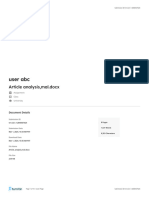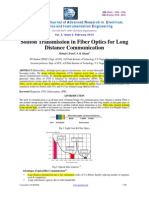Hina 3
Hina 3
Uploaded by
Erika AcquiatanCopyright:
Available Formats
Hina 3
Hina 3
Uploaded by
Erika AcquiatanOriginal Title
Copyright
Available Formats
Share this document
Did you find this document useful?
Is this content inappropriate?
Copyright:
Available Formats
Hina 3
Hina 3
Uploaded by
Erika AcquiatanCopyright:
Available Formats
Page 1 of 5 - Cover Page Submission ID trn:oid:::1:2875785936
Historic-RRL.docx
Assignment
Class
University
Document Details
Submission ID
trn:oid:::1:2875785936 3 Pages
Submission Date 1,210 Words
Apr 5, 2024, 1:21 PM UTC
7,251 Characters
Download Date
Apr 5, 2024, 1:21 PM UTC
File Name
tmp9otymzwg
File Size
15.6 KB
Page 1 of 5 - Cover Page Submission ID trn:oid:::1:2875785936
Page 2 of 5 - AI Writing Overview Submission ID trn:oid:::1:2875785936
How much of this submission has been generated by AI?
86%
Caution: Percentage may not indicate academic misconduct. Review required.
It is essential to understand the limitations of AI detection before making decisions
about a student's work. We encourage you to learn more about Turnitin's AI detection
capabilities before using the tool.
of qualifying text in this submission has been determined to be
generated by AI.
Frequently Asked Questions
What does the percentage mean?
The percentage shown in the AI writing detection indicator and in the AI writing report is the amount of qualifying text within the
submission that Turnitin's AI writing detection model determines was generated by AI.
Our testing has found that there is a higher incidence of false positives when the percentage is less than 20. In order to reduce the
likelihood of misinterpretation, the AI indicator will display an asterisk for percentages less than 20 to call attention to the fact that
the score is less reliable.
However, the final decision on whether any misconduct has occurred rests with the reviewer/instructor. They should use the
percentage as a means to start a formative conversation with their student and/or use it to examine the submitted assignment in
greater detail according to their school's policies.
How does Turnitin's indicator address false positives?
Our model only processes qualifying text in the form of long-form writing. Long-form writing means individual sentences contained in paragraphs that make up a
longer piece of written work, such as an essay, a dissertation, or an article, etc. Qualifying text that has been determined to be AI-generated will be highlighted blue
on the submission text.
Non-qualifying text, such as bullet points, annotated bibliographies, etc., will not be processed and can create disparity between the submission highlights and the
percentage shown.
What does 'qualifying text' mean?
Sometimes false positives (incorrectly flagging human-written text as AI-generated), can include lists without a lot of structural variation, text that literally repeats
itself, or text that has been paraphrased without developing new ideas. If our indicator shows a higher amount of AI writing in such text, we advise you to take that
into consideration when looking at the percentage indicated.
In a longer document with a mix of authentic writing and AI generated text, it can be difficult to exactly determine where the AI writing begins and original writing
ends, but our model should give you a reliable guide to start conversations with the submitting student.
Disclaimer
Our AI writing assessment is designed to help educators identify text that might be prepared by a generative AI tool. Our AI writing assessment may not always be accurate (it may misidentify
both human and AI-generated text) so it should not be used as the sole basis for adverse actions against a student. It takes further scrutiny and human judgment in conjunction with an
organization's application of its specific academic policies to determine whether any academic misconduct has occurred.
Page 2 of 5 - AI Writing Overview Submission ID trn:oid:::1:2875785936
Page 3 of 5 - AI Writing Submission Submission ID trn:oid:::1:2875785936
A significant juncture in the history of firefighting in Zamboanga City occurred during the revival of the
department between 1951 and 1955. This time was highlighted by skill growth, technical breakthroughs,
and rehabilitation. It is important to comprehend the circumstances for the Zamboanga City Fire
Station’s restoration at this time as mentioned by Montgomery, Mark R. (2008), A more resilient
firefighting system is desperately needed, as demonstrated by the destruction inflicted by fires in recent
years. A modernization of firefighting skills was required due to factors including urbanization,
population increase, and the rising complexity of structures (Asian Development Bank. 2014).
According to the study conducted by Taylor, M., Higgins, E., Lisboa, P., Jarman, I., & Hussain, A. (2016),
improving fire prevention and response systems was the main driving force for the rebuilding of the
Zamboanga City Fire Station. The shortcomings of the current apparatus and infrastructure in controlling
fires were acknowledged by the city administration. As a result, a thorough plan was developed to
update the fire station that included both structural upgrades and the purchase of cutting-edge fire
fighting equipment as denoted by Guardiano, J. Harrmeyer, D. & Poole, R. (1922). This repair project was
motivated by a dedication to protecting people and property, demonstrating a proactive stance towards
mitigating the increasing hazards of fire in Zamboanga City.
From 1951 to 1955, There have been notable advancements in the facilities and apparatus of the
Zamboanga City Fire Station. The acquisition of cutting-edge firefighting apparatus designed to address
the changing demands of urbanization and industry was essential to this advancement. During this time,
newer fire vehicles with better water delivery systems, more agility, and a larger capacity to fight a wider
range of flames were acquired. Additionally, expenditures were made on specialized equipment and
supplies, such as state-of-the-art hoses, nozzles, and protective gear, equipping firemen with the tools
they need to handle situations successfully (Robinson, L., Johnston, P. B., & Oak, G. S. 2016).
During the time of revival, the Zamboanga City Fire Station had significant improvements to its physical
infrastructure. Old, decaying buildings were swapped out for newly constructed ones that were intended
to maximize operational effectiveness and meet the growing demands of the firefighting staff. The new
fire station was positioned to minimize the impact of fires on neighborhoods and businesses by
guaranteeing quick reaction times to various regions of the city. A culture of ongoing education and
professional growth was also promoted by the establishment of training facilities on the station grounds,
which improved the competencies and skills of firefighters (MEDINA, M. C. T. 2016).
The existence of Zamboanga City’s fire department throughout this time period serves as a symbol of the
incredible progress made in developing the knowledge and talents of firefighting professionals. A
deliberate effort was made to improve firefighters’ training and skill since it was realized that fighting
fires effectively required more than simply infrastructure and equipment. Strict training programs were
established to teach vital firefighting skills, such as managing hazardous items, search and rescue, and
fire suppression. In order to give firefighters the knowledge and skills necessary to handle challenging
Page 3 of 5 - AI Writing Submission Submission ID trn:oid:::1:2875785936
Page 4 of 5 - AI Writing Submission Submission ID trn:oid:::1:2875785936
emergency situations, specific training in industrial fire control and high-rise firefighting was also
implemented (Rajaretnam, M. 1976).
The resurgence of the Zamboanga City Fire Department involved more than just advances in technology
and infrastructure; it also involved a fundamental change in the tactics and methods used to combat
fires. In order to reduce fire hazards and enhance community safety, the fire department implemented
proactive measures by adopting a comprehensive approach to fire prevention and mitigation. To inform
locals about fire safety precautions, such as installing smoke detectors, handling combustible goods
carefully, and evacuation protocols, public awareness programs were started. In order to promote
cooperation between the fire service and local stakeholders and highlight our shared accountability for
maintaining fire resilience, community engagement programs have also been implemented (Fabian, M.
2004).
The years 1951 to 1955 were a pivotal time in the Zamboanga City Fire Department’s history, defined by
fortitude, inventiveness, and a resolute dedication to serving the people. The fire station’s restoration,
together with improvements in tools and instruction, set the stage for the development of a
contemporary firefighting force that could successfully handle the difficulties of the day. Furthermore,
the fire department’s all-encompassing strategy highlighted how crucial community collaborations and
proactive fire prevention measures are to protecting people and property. The revival of Zamboanga
City’s fire department was evidence of the city’s steadfast commitment to readiness and resilience in the
face of misfortune as it developed and grew (City Government of Zamboanga 1998).
Zamboanga City underwent rapid urbanization and economic expansion during this time, which resulted
in an increase in the number of residential and commercial buildings. Since more complex and densely
populated structures required more advanced firefighting tools and procedures, the city’s built
environment expanded quickly, posing special obstacles for firefighting operations. Additionally, the
emergence of new fire threats due to industrialization—such as chemical plants, warehouses, and
factories—highlights the necessity of updating the fire department in order to successfully reduce these
risks (Dans, S.A. 1999).
The rebuilding of the Zamboanga City Fire Station was a team effort involving several stakeholders,
including public and commercial sector organizations as well as community groups. These stakeholders
supported the reconstruction effort financially, technically, and logistically, realizing how important the
fire department is to maintaining both public safety and economic stability. The resilience of Zamboanga
City’s firefighting infrastructure was strengthened by this collaborative culture, which promoted a feeling
of unity and common purpose (City of Zamboanga 2019).
Page 4 of 5 - AI Writing Submission Submission ID trn:oid:::1:2875785936
Page 5 of 5 - AI Writing Submission Submission ID trn:oid:::1:2875785936
The redevelopment of the Zamboanga City Fire Department included not just structural improvements
and equipment upgrades but also a fresh focus on risk management and fire prevention. To find any risks
and make sure safety rules were being followed, code enforcement and fire inspections were stepped up
As stated by Hassanain, M. Harogi, M. & Ibrahim, A. (2022). Revisions to building regulations have
included provisions for fire-resistant materials and design concepts, therefore mitigating the risk of
structural fire damage. Additionally, public outreach initiatives were broadened to include
underprivileged areas and informal settlements, as well as other vulnerable groups, equipping locals
with the information and tools they need to put out fires and successfully handle catastrophes.
Moreover, professionalization of the firefighting profession was sparked by the revival of the Zamboanga
City Fire Department. In order to recruit and retain talented workers, career routes and training
standards were raised, as highlighted by Aronoff, S., and Kaplan, A. (1995). To provide firefighters the
skills they need to succeed in their jobs, specialized training programs in leadership, emergency medical
response, and incident command were created as stated by Furness, A., and Muckett, M. (2007). In order
to promote information sharing and skill development and keep Zamboanga City’s firemen at the
forefront of their industry, alliances were also formed with academic institutions and professional
bodies.
Urbanization, industrialization, and socioeconomic expansion have all contributed to the fire
department’s rise to prominence as a symbol of preparation and resilience, able to protect people and
property from ever-increasing fire hazards. The memory of this revival persisted as Zamboanga City
developed, encouraging succeeding firefighting generations to preserve the principles of bravery,
professionalism, and community service (Zalok, E., Hadji Sophocleous, G. V., and Mehaffay, J. R. 2008).
Page 5 of 5 - AI Writing Submission Submission ID trn:oid:::1:2875785936
You might also like
- Arlington Police Report: Six Flags Over Texas InvestigationDocument86 pagesArlington Police Report: Six Flags Over Texas Investigationwfaachannel8100% (1)
- Letter of Motivation For International Energy EngineeringDocument5 pagesLetter of Motivation For International Energy EngineeringChristopher WalkerNo ratings yet
- CommunityDocument5 pagesCommunityjohanna floraNo ratings yet
- Document Details: Page 1 of 30 - Cover Page Submission ID Trn:oid:::1:2880979003Document30 pagesDocument Details: Page 1 of 30 - Cover Page Submission ID Trn:oid:::1:2880979003clothbaby12No ratings yet
- ReportDocument9 pagesReportHassanNo ratings yet
- 0a494cad04bf5dba AI Tmpr69gi - m9Document8 pages0a494cad04bf5dba AI Tmpr69gi - m9Mashaal FNo ratings yet
- Intl 2373055382 AIDocument13 pagesIntl 2373055382 AIodongoerick90No ratings yet
- Extended Abstract-Ver2Document8 pagesExtended Abstract-Ver2kp.hewagamageNo ratings yet
- AIReport (1245)Document14 pagesAIReport (1245)Samson HenryNo ratings yet
- 2b7ae3745dffb295-AI-tmpa g8 n00Document9 pages2b7ae3745dffb295-AI-tmpa g8 n00Zia Ur RehmanNo ratings yet
- Ai ReportDocument10 pagesAi ReportmujeebblouchNo ratings yet
- 54c9c1684e29f850 AI Tmpat - f3htfDocument6 pages54c9c1684e29f850 AI Tmpat - f3htfmalikshoaib5568No ratings yet
- FWD LS 3922 T Principles of Operations Managemen EssayDocument12 pagesFWD LS 3922 T Principles of Operations Managemen EssaySayan BiwasNo ratings yet
- CH 1 Impact of AI On Green HRM PracticesDocument9 pagesCH 1 Impact of AI On Green HRM PracticesAbdul GhaffarNo ratings yet
- 8cb1017084f22e39 AI Tmpwnodzc - FDocument14 pages8cb1017084f22e39 AI Tmpwnodzc - FMashaal FNo ratings yet
- Innovation Management File1Document30 pagesInnovation Management File1aishariaz342No ratings yet
- AI-Project New Report 1-1.docx F3df8232ab7f20d2Document14 pagesAI-Project New Report 1-1.docx F3df8232ab7f20d2irsa.abidNo ratings yet
- WebinarDocument7 pagesWebinarPaul OgayeNo ratings yet
- Principles of Project Management Assessment 2Document9 pagesPrinciples of Project Management Assessment 2masod2699No ratings yet
- BM303Document10 pagesBM303iambicpentameter4No ratings yet
- AI-Report ProposalDocument10 pagesAI-Report ProposalMuhammad Waleed KhanNo ratings yet
- 274 Ai ScanDocument11 pages274 Ai ScanAshley BooNo ratings yet
- Thesis Research Paper SampleDocument27 pagesThesis Research Paper Sampledua95960No ratings yet
- Intl 2373449290 AIDocument33 pagesIntl 2373449290 AIsreejithsankarankutty7No ratings yet
- Gss 2 Netflix - Assessment 2Document25 pagesGss 2 Netflix - Assessment 2Solomon PervaizNo ratings yet
- Engineering Towards Industry 4.0 Using Data-Driven MethodsDocument7 pagesEngineering Towards Industry 4.0 Using Data-Driven MethodsHafizshoaib381No ratings yet
- Bfc2d52d4b6c0568 AI Tmp9xarpctDocument19 pagesBfc2d52d4b6c0568 AI Tmp9xarpctrateme3530No ratings yet
- AI-Judith Reflection 4.Document4 pagesAI-Judith Reflection 4.mujeebblouchNo ratings yet
- 3e99a7ab8d6861ac AI Tmpu7a36a48Document15 pages3e99a7ab8d6861ac AI Tmpu7a36a48hafizshoaib5567No ratings yet
- IB ProjectDocument45 pagesIB ProjectDhruv KapoorNo ratings yet
- BM302Document9 pagesBM302iambicpentameter4No ratings yet
- Technology-Based Instruction and Motivated Learning Strategies As Predictor of Student EngagementDocument95 pagesTechnology-Based Instruction and Motivated Learning Strategies As Predictor of Student Engagementvinceangelo.mabidaNo ratings yet
- AI intl-2289671856-AIDocument5 pagesAI intl-2289671856-AIobareombocheclintonNo ratings yet
- AI-APPLIED MARKETS AND ECONOMICS .Docx 46bdec75c78b3925Document3 pagesAI-APPLIED MARKETS AND ECONOMICS .Docx 46bdec75c78b3925david.ellis1245No ratings yet
- M4.3 Learning ReflectionDocument4 pagesM4.3 Learning ReflectionLearn Solve ShareNo ratings yet
- Personal StatementDocument7 pagesPersonal Statementkarimindustries1No ratings yet
- Turnitin Report3Document8 pagesTurnitin Report3ahsankhangeminiNo ratings yet
- Assignment 1 Amazon Vs AlibabaDocument13 pagesAssignment 1 Amazon Vs AlibabaShamsa KanwalNo ratings yet
- AI-ETAM - Copy - Docx E09450d67aa0d993Document25 pagesAI-ETAM - Copy - Docx E09450d67aa0d993Vinay KumarNo ratings yet
- Community Assessment Project Part 3 1Document13 pagesCommunity Assessment Project Part 3 1Techloggie ProductionNo ratings yet
- Transnational Cultural Phenomenon MusicDocument9 pagesTransnational Cultural Phenomenon MusicyayazuberiNo ratings yet
- AIReportDocument5 pagesAIReportpatiencefelistusNo ratings yet
- Community Assessment Project Part 3 1Document14 pagesCommunity Assessment Project Part 3 1Techloggie ProductionNo ratings yet
- Erasmus Mundus Personal Statement DraftDocument4 pagesErasmus Mundus Personal Statement DraftAli HassnainNo ratings yet
- Intl 2373089829 AIDocument6 pagesIntl 2373089829 AIodongoerick90No ratings yet
- Discussion 12Document3 pagesDiscussion 12Garvin OrtizNo ratings yet
- FixedDocument17 pagesFixedNhung UmiNo ratings yet
- Intl 2326226472 AIDocument5 pagesIntl 2326226472 AIJosephNo ratings yet
- AI UKAH 10019431complete - Docx Dabd5bf653a09ff1Document35 pagesAI UKAH 10019431complete - Docx Dabd5bf653a09ff1iamelenagraceNo ratings yet
- SPC ImplememtationDocument17 pagesSPC ImplememtationHafizshoaib381No ratings yet
- Summary 1Document4 pagesSummary 1ompriyarathNo ratings yet
- 3478241849ca0d46 AI Tmpbq06ody1Document46 pages3478241849ca0d46 AI Tmpbq06ody1Sam SamNo ratings yet
- Order 6497886 International Dimensions of SecurityDocument5 pagesOrder 6497886 International Dimensions of Securitytdywaweru5No ratings yet
- Elevator SpeechDocument6 pagesElevator Speechinfobrains05No ratings yet
- Im Im: Document DetailsDocument25 pagesIm Im: Document Detailsaishariaz342No ratings yet
- BSS054-6 Risk and Procurement ManagementDocument19 pagesBSS054-6 Risk and Procurement ManagementSaqline Ahmed RoktimNo ratings yet
- Autonomous Learning - Docx: Document DetailsDocument13 pagesAutonomous Learning - Docx: Document Detailssedobi1512No ratings yet
- 2438 - AI DetectionDocument12 pages2438 - AI Detectionjnrius.alxnderNo ratings yet
- Event PlanningDocument8 pagesEvent PlanningdeNo ratings yet
- Document Details: Page 1 of 19 - Cover Page Submission ID Trn:oid:::1:2837255414Document19 pagesDocument Details: Page 1 of 19 - Cover Page Submission ID Trn:oid:::1:2837255414mesay83No ratings yet
- Sae J49-2020Document11 pagesSae J49-2020Marcos RosenbergNo ratings yet
- The Thive Story AusabelDocument7 pagesThe Thive Story AusabelYash RajNo ratings yet
- ILMPDocument1 pageILMPJudy Lyn MahusayNo ratings yet
- NBesinovic PHD ThesisDocument249 pagesNBesinovic PHD ThesisTherill FakNo ratings yet
- Impossible Chocolate Flan Cake - Kawaling PinoyDocument2 pagesImpossible Chocolate Flan Cake - Kawaling PinoyArdm24No ratings yet
- Maharashtra State Board of Technical EducationDocument5 pagesMaharashtra State Board of Technical EducationKrishna PujeriNo ratings yet
- 7 Soliton PDFDocument8 pages7 Soliton PDFAnonymous K9F6Z7LwuNo ratings yet
- Inyectores Delphi Tabla ValoresDocument30 pagesInyectores Delphi Tabla Valoresbruttus139No ratings yet
- NATO Chicago Economic ImpactDocument15 pagesNATO Chicago Economic ImpactPATRIOTSKULLZNo ratings yet
- Disaster Risk Reduction Management LectureDocument19 pagesDisaster Risk Reduction Management LectureJames Joseph ObispoNo ratings yet
- Energy Changes Foundation Revision Activity MatDocument2 pagesEnergy Changes Foundation Revision Activity MatHồng Ngọc VõNo ratings yet
- Multiple Emulsion ReviewDocument11 pagesMultiple Emulsion ReviewverygoodbrotherNo ratings yet
- Technical Analysis ElearnDocument44 pagesTechnical Analysis ElearnRavi Tomar100% (4)
- BhartiAxa Annual ReportDocument81 pagesBhartiAxa Annual ReportAshish TiwariNo ratings yet
- CPSC IG Letter ExhibitsDocument250 pagesCPSC IG Letter ExhibitsCause of ActionNo ratings yet
- Accounting For Derivative Instruments and Hedging ActivitiesDocument16 pagesAccounting For Derivative Instruments and Hedging Activitiesst666asNo ratings yet
- Vehicle Diagnostic Tool Ref ChartDocument3 pagesVehicle Diagnostic Tool Ref ChartAndrew MeyerNo ratings yet
- Geological Survey of Great Britain - L The Country Around Holmfirth and GlossopDocument233 pagesGeological Survey of Great Britain - L The Country Around Holmfirth and GlossopCraig BurtonNo ratings yet
- Eclipse 2008 2.4LDocument142 pagesEclipse 2008 2.4LDiego.S SanchezNo ratings yet
- PackRyt BLR Longevity ChartDocument1 pagePackRyt BLR Longevity ChartGonzalo Alonso QuintanaNo ratings yet
- Economic Management Principles - Explanation and IllustrationDocument13 pagesEconomic Management Principles - Explanation and IllustrationNguyên Văn NhậtNo ratings yet
- Cuke4ninja CucumberDocument128 pagesCuke4ninja Cucumbermahi_dNo ratings yet
- ILRYU General PresentationDocument8 pagesILRYU General PresentationAbdullahNo ratings yet
- CA MammaeDocument30 pagesCA MammaeAlfiany SahrNo ratings yet
- E10 - Unit 5 - Practice Exercise No.1Document10 pagesE10 - Unit 5 - Practice Exercise No.1Lâm TùngNo ratings yet
- Lesson Plan For StartersDocument5 pagesLesson Plan For StartersGel Rose Mariano Padilla GelNo ratings yet
- RL 609Document2 pagesRL 609ashokNo ratings yet
- DLL - Science 6 - Q1 - W8Document3 pagesDLL - Science 6 - Q1 - W8janeNo ratings yet
- Astm D1621-16 (2023)Document3 pagesAstm D1621-16 (2023)wenhsiaochuanNo ratings yet

























































































